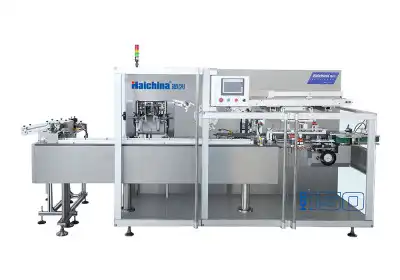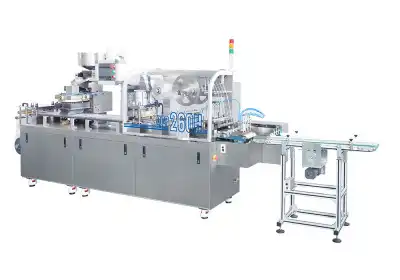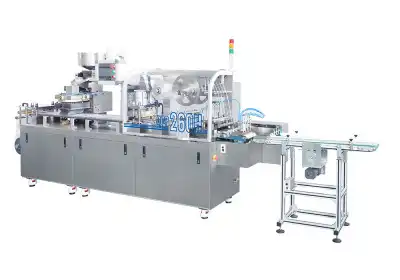Understanding Automatic Cartoning Machines in Pharmaceutical Packaging
The Mechanics of Automatic Cartoning
Automatic cartoning machines are sophisticated pieces of equipment designed to streamline the packaging process. These machines automate the task of placing products into cartons, significantly reducing manual labor and increasing production efficiency. In the pharmaceutical industry, where precision and hygiene are paramount, automatic cartoning machines play a crucial role in maintaining product integrity and ensuring regulatory compliance.
Advantages of Automatic Cartoning for Pharma Products
The benefits of using automatic cartoning machines in pharmaceutical packaging are numerous. These systems offer unparalleled speed and accuracy, capable of handling hundreds of units per minute with minimal errors. They also provide flexibility in packaging design, accommodating various carton sizes and styles to suit different product lines. Moreover, automatic cartoning machines can be integrated with other packaging equipment, creating a seamless production flow that enhances overall efficiency.
Customization and Scalability
One of the key strengths of automatic cartoning machines is their adaptability. Manufacturers can customize these machines to meet specific pharmaceutical packaging requirements, including the integration of serialization and track-and-trace systems. As production needs grow, many automatic cartoning systems can be scaled up, allowing pharmaceutical companies to increase their packaging capacity without completely overhauling their equipment.
Blister Packaging Machines: A Closer Look at Pharmaceutical Applications
The Science Behind Blister Packaging
Blister packaging machines are engineered to create individual, sealed compartments for each unit of a pharmaceutical product. This packaging method involves forming a cavity in a plastic film, placing the product into the cavity, and then sealing it with a backing material, typically foil. The process not only protects the product from environmental factors but also provides a tamper-evident package that ensures product integrity.
Benefits of Blister Packaging in the Pharmaceutical Industry
Blister packaging offers several advantages for pharmaceutical products. It provides excellent moisture and oxygen barrier properties, which are essential for preserving the efficacy of many medications. The individual packaging of each dose also improves patient compliance by making it easier to track medication intake. Additionally, blister packaging, when used with an automatic cartoning machine, enhances the shelf life of products and offers superior protection against contamination.
Versatility and Product Visibility
Blister packaging machines can accommodate a wide range of pharmaceutical products, from tablets and capsules to medical devices. The transparent nature of the packaging allows for easy visual inspection of the product, which is beneficial for both quality control and consumer confidence. This visibility can also serve as a marketing advantage, allowing the product to be prominently displayed at the point of sale.
Comparative Analysis: Automatic Cartoning vs Blister Packaging for Pharmaceutical Use
Production Efficiency and Output
When comparing automatic cartoning machines to blister packaging machines, production efficiency is a key consideration. Automatic cartoning machines generally offer higher output rates, making them suitable for large-scale pharmaceutical production. They can handle a variety of product sizes and shapes, allowing for greater flexibility in packaging design. Blister packaging machines, while potentially slower, provide a level of product protection that is often essential for sensitive pharmaceuticals.
Cost Considerations and Return on Investment
The initial investment for automatic cartoning machines can be significant, but their high-speed operation and reduced labor requirements often result in a favorable return on investment for high-volume production. Blister packaging machines may have lower upfront costs but can incur higher ongoing expenses due to the specialized materials required. The choice between the two often depends on the specific product requirements and production volumes of a pharmaceutical company.
Regulatory Compliance and Quality Assurance
Both automatic cartoning and blister packaging machines can be designed to meet stringent pharmaceutical industry regulations. However, blister packaging often has an edge when it comes to providing tamper-evident and child-resistant packaging, which are critical factors in many pharmaceutical applications. Automatic cartoning machines can be equipped with vision systems and other quality control measures to ensure packaging integrity, but may require additional steps to achieve the same level of tamper-evidence as blister packaging.
Conclusion
Choosing between automatic cartoning machines and blister packaging machines for pharmaceutical applications requires careful consideration of various factors. Automatic cartoning offers high-speed production and versatility, making it ideal for large-scale operations with diverse product lines. Blister packaging, on the other hand, provides superior product protection and compliance features, which are crucial for many medications. The best choice ultimately depends on the specific needs of the pharmaceutical company, including product characteristics, production volume, and regulatory requirements. By carefully evaluating these factors, manufacturers can select the packaging solution that best aligns with their operational goals and product specifications.
FAQs
1. What is the main difference between automatic cartoning and blister packaging machines?
Automatic cartoning machines package products into cartons, while blister packaging machines create individual sealed compartments for each unit.
2. Which packaging method is more suitable for moisture-sensitive pharmaceuticals?
Blister packaging generally provides better moisture protection for sensitive pharmaceuticals.
3. Can automatic cartoning machines handle different product sizes?
Yes, automatic cartoning machines are highly versatile and can be adjusted to accommodate various product sizes and shapes.
4. Are blister packaging machines compliant with pharmaceutical regulations?
Blister packaging machines can be designed to meet pharmaceutical industry regulations, including tamper-evidence and child-resistance requirements.
5. Which packaging method is more cost-effective for high-volume production?
Automatic cartoning machines are often more cost-effective for high-volume production due to their speed and efficiency.
Expert Packaging Solutions for Pharmaceutical Industry | Haichina
At Zhejiang Haizhong Machinery Co., Ltd., we specialize in providing top-tier automatic cartoning machines and comprehensive packaging solutions for the pharmaceutical industry. As a leading manufacturer and supplier, our equipment combines innovation with reliability, meeting CE, cGMP, and ISO 9001 standards. Our expert team offers customized solutions to meet your specific packaging needs, ensuring efficiency and compliance in your production line. For inquiries about our automatic cartoning machines or other packaging equipment, contact us at [email protected].
References
Johnson, M. (2022). "Pharmaceutical Packaging Technologies: A Comprehensive Review." Journal of Drug Delivery Science and Technology, 68, 103072.
Smith, A. et al. (2021). "Comparative Analysis of Automatic Cartoning and Blister Packaging in the Pharmaceutical Industry." International Journal of Pharmaceutics, 592, 120092.
Brown, R. (2023). "Advancements in Automatic Cartoning Machines for Pharmaceutical Applications." Pharmaceutical Technology, 47(5), 30-35.
Lee, S. and Kim, J. (2022). "Blister Packaging: Ensuring Product Integrity in the Pharmaceutical Supply Chain." Drug Development and Industrial Pharmacy, 48(3), 345-358.
Garcia, C. et al. (2021). "Efficiency and Cost-Effectiveness of Packaging Technologies in Pharmaceutical Manufacturing." Journal of Pharmaceutical Innovation, 16(2), 289-301.
Wilson, D. (2023). "Regulatory Considerations for Pharmaceutical Packaging: A Focus on Cartoning and Blister Systems." Regulatory Toxicology and Pharmacology, 131, 105149.




